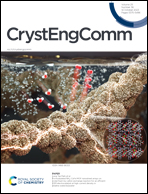Reaction controlled growth with formic acid for high-quality Cs3Cu2I5 single crystals†
Abstract
The recent emergence of low-dimensional copper-based halide perovskite Cs3Cu2I5, for use in optoelectronics and radiation detection, has evoked considerable interest. Presently, Cs3Cu2I5 single crystals grown using solution methods barely have clearly defined crystal planes and the crystal quality remains inferior. In this work, we have achieved high-quality Cs3Cu2I5 single crystals featuring prominent crystal habit planes through reducing the growth rate by controlling the concentration of I− ions via the addition of formic acid. The slow reaction between I3− and formic acid at a lower growth temperature can effectively control the concentration of I− ions in the solution, thereby reducing the growth rate and extending the metastable growth range simultaneously. This optimized process can yield high-quality single crystals, with a reduced full width at half maxima (FWHM) of 0.047° for the X-ray rocking curve on the (002) natural crystal habit plane, a substantially improved energy resolution of 7.1% for a photon energy of 511 keV, and an increased absolute light yield to 39 000 photons per MeV. Our study demonstrates that the reaction-controlled growth may be an effective way to improve the crystal quality of the copper-based halide perovskite.



 Please wait while we load your content...
Please wait while we load your content...